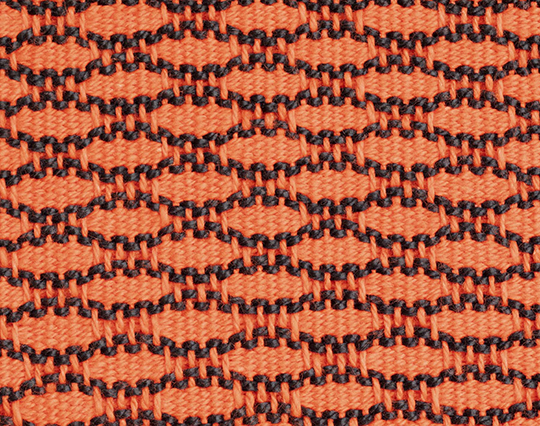Honeycomb
Marcy Petrini
April, 2020
I learned about honeycomb when I took a class that included overshot. Mary Black in New Key to Weaving describes it as “one that can be treadled on many overshot drafts.” Thus honeycomb is a treadling method.
As overshot, honeycomb uses one warp, generally threaded in an overshot pattern, and two wefts. In overshot, the heavy thread forms the floats of the block and the lighter thread, usually the same size as the warp, forms the background cloth. But in honeycomb, the body of the block is woven with the same size thread as the warp and a heavier thread outlines the blocks, forming the lattice that resembles a honeycomb from which the weave gets its name.
Because it had been a long time since I had woven honeycomb, I decided that in order to include it in the Pictionary©, I would have to weave a sample – and not use one that was the better part of 40 years old! Plus, I must admit that I find it hard to write about something unless I have woven it recently, or at least more recently that 40 years!
I used the simplest overshot threading which actually is Monk’s Belt, two blocks with no shaft shared. Some consider Monk’s Belts a type of overshot, some a separate structure, but even the splitters would agree that, when woven the traditional way, Monk’s Belt is a supplementary weft weave like overshot.
Below is the drawdown. The warp is orange and the cell weft is a lighter orange to show the intersections better; in the fabric it is the same yarn. The blue weft is the heavier thread.

Click here for the full-sized draft (a PDF will open a new window or in your list of downloaded files)
The draft tells us how to weave honeycomb but is not very illustrative of the look of the fabric that results from the draft.
Compare the drawdown with the fabric below. The warp and cell weft for this sample is 6/2 orange unmercerized cotton and the outline yarn is 3/2 Pacific blue mercerized cotton. Six shots of the 6/2 were used to weave the cells, as shown in the drawdown.

We weave two shots of the heavier blue thread, using the usual tabbies for overshot, 1 & 3 vs. 2 & 4; 6 shots of the thinner orange thread follow; we finish the sequence with two more shots of the blue thread, which are also the beginning of the next sequence.
While one block of Monk’s Belt weaves plain weave, the other forms long warp floats; these long floats pull the blue weft so that it bends around the plain weave block and compresses it – and the long warp floats are shortened. The resulting fabric alternates staggered “honeycomb” cells; in the next sequence, the block that wove plain weave now weaves long floats and the block that had long floats now weaves plain weave.
As shown in the draft and as I have already mentioned, there are 6 shots of thin orange weft per sequence, but that number can be changed. Below is a sample on the same warp that uses 3/2 black mercerized cotton with 8 picks instead of 6. The warp floats are more apparent.

Next, I decided to use the 6/2 orange cotton to outline the cells and a thinner 10/2 mercerized cotton, yellow, for the cells. This was not an original idea, but I can’t remember where I had learned about it. Below is the fabric. The orange warp ends are even more noticeable. The yellow 10/2 cotton covers the orange warp completely making the cells weft-faced.

And finally, I couldn’t resist glitz. Here is the same treadling as the original drawdown and sample, but the blue weft was replaced by a multicolor yarn from my shelf, Ausermann High Collection Holiday, 50 gm = 115 m; 82% viscose, 15% polyamid, 3% polyester.

I can imagine an evening jacket with such a fabric!
When designing with this weave, we need to remember the floats in the back. Where there are warp floats in the front, the weft floats in the back. The photo below shows the back of the 1st fabric; the orange weft floats between two plain weave blocks. An example of a weft float block is shown in the picture circled in light blue. If the floats in the back are too long, solutions could include lining a jacket, using the fabric for a pillow, etc.

There is a lot of room for experimenting with this weave; if you want to explore more, try Stacey Harvey-Brown’s book, Honeycomb Hybrids. Honeycomb for All Tastes for some interesting possibilities.
Happy Weaving!
Please email comments and questions to
